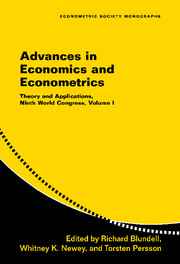Book contents
- Frontmatter
- Contents
- Contributors
- Introduction by the Editors
- Advances in Economics and Econometrics
- 1 The Economics of Social Networks
- 2 Multi-Contracting Mechanism Design
- 3 Allocative and Informational Externalities in Auctions and Related Mechanisms
- 4 The Economics of Relationships
- 5 Information in Mechanism Design
- 6 Communication in Economic Mechanisms
- 7 Advances in Dynamic Optimal Taxation
- 8 Quantitative Macroeconomic Models with Heterogeneous Agents
- 9 Modeling Inefficient Institutions
- 10 Whither Political Economy? Theories, Facts and Issues
- 11 Comments on Acemoglu and Merlo
- Index
- Titles in the series
9 - Modeling Inefficient Institutions
Published online by Cambridge University Press: 05 January 2013
- Frontmatter
- Contents
- Contributors
- Introduction by the Editors
- Advances in Economics and Econometrics
- 1 The Economics of Social Networks
- 2 Multi-Contracting Mechanism Design
- 3 Allocative and Informational Externalities in Auctions and Related Mechanisms
- 4 The Economics of Relationships
- 5 Information in Mechanism Design
- 6 Communication in Economic Mechanisms
- 7 Advances in Dynamic Optimal Taxation
- 8 Quantitative Macroeconomic Models with Heterogeneous Agents
- 9 Modeling Inefficient Institutions
- 10 Whither Political Economy? Theories, Facts and Issues
- 11 Comments on Acemoglu and Merlo
- Index
- Titles in the series
Summary
INTRODUCTION
Many economists and social scientists have recently emphasized the importance of government policies, economic, political and legal institutions, and more broadly, the organization of society. There is also mounting evidence that various institutional features are indeed important for economic growth. Nevertheless, despite important theoretical advances, we still lack an organizational framework to analyze the determinants of institutions. In particular, if institutions matter (so much) for economic performance, why do societies choose or end up with institutions that do not maximize economic growth or aggregate economic welfare? This paper discusses potential answers to this question.
The main focus is on modeling the emergence and persistence of inefficient institutions, meaning institutions that do not maximize the growth potential of a society. The purpose of the paper is not to provide a survey but to construct a relatively simple unified model that illustrates both various issues already raised in the existing literature and a number of new mechanisms that appear to be important in understanding inefficient institutions.
To understand why inefficient institutions emerge and persist, we first need to understand: (i) what type of equilibrium policies and allocations emerge within different institutional frameworks; (ii) the preferences of different individuals and groups over these policies and allocations. This will enable us to derive induced preferences over institutions. Inefficient institutions will emerge and persist, in turn, when groups that prefer the inefficient (non-growth enhancing) policies that these institutions generate are sufficiently powerful, and when other social arrangements that compensate these powerful groups, while reaching more efficient allocations, cannot be found.
- Type
- Chapter
- Information
- Advances in Economics and EconometricsTheory and Applications, Ninth World Congress, pp. 341 - 380Publisher: Cambridge University PressPrint publication year: 2006
- 18
- Cited by

